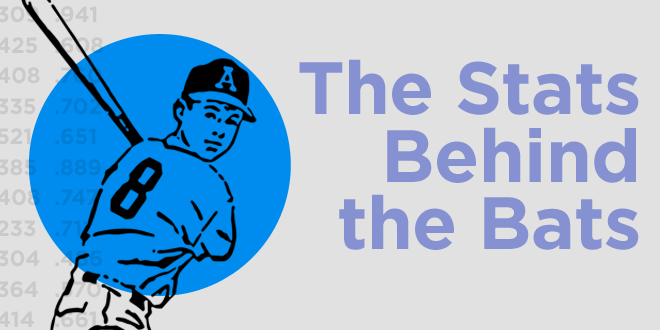The Stats Behind the Bats
Laura DeMoss |
June 12, 2015
As the NMSI team kicks off summer, we are excited to have a new cadre of interns joining us. In the coming weeks, we'll share their viewpoints on math, science, education and what they are learning from their internships. Today we hear from Nathan Mathai, our marketing and communications intern joining us from Furman University in South Carolina, about the math behind a favorite summer sport.
 Baseball has always been America’s favorite summer pastime. We love the smell of fresh-cut grass and singing along with the national anthem. We love the ceremonial first pitch and the snap of the bat meeting the ball. We love hotdogs and the mess of cracked peanuts. And we love the math.
Baseball has always been America’s favorite summer pastime. We love the smell of fresh-cut grass and singing along with the national anthem. We love the ceremonial first pitch and the snap of the bat meeting the ball. We love hotdogs and the mess of cracked peanuts. And we love the math.
Yes, that’s right. We love the math.
Honestly, what’s better than the math of the game? What keeps kids on the hunt for little pieces of cardstock pictures and has adults wrestling each other (and sometimes kids!) for a leather ball? It’s the game of math.
When most people hear the word baseball they automatically hear “You’re killing me, Smalls!” and “Hey, batter, batter!” or they start humming the infamous tune “Take Me Out to the Ballgame.” But America’s pastime is also connected to the game that Descartes, Euclid and Archimedes used to play.
Math is part of every sport: scores, rankings, game clocks, timeouts and even the scheduling of tournaments are all about the numbers. But in baseball, it’s the math behind the individual player – whether that player realizes it or not – that has become critical to understanding why the game is played the way it is.
Let’s start with one of the simple calculations that happens within the game – the batter’s reaction time. In order to hit the ball, the batter must be able to perceive how fast that ball is approaching in relation to where it was released and where he wants the bat to hit the ball. Assuming an average ball travels at 90 mph in the major leagues and the plate is 60 feet, 6 inches away from the mound, the average reaction time comes down to 0.458 seconds. That’s some quick calculating and it’s critical to the game. From mid-February to early October, someone somewhere is doing the math in his head each time he is up to bat.
There are numerous other calculations that are key to the game. Often referred to as the “Triple Crown”, batting average, runs batted in (RBI) and home runs are considered the core numbers to look at when analyzing the value of a player.
Recently, the relationship between math and the game has boomed with the rise of sabermetrics. Named in part to honor the Society for American Baseball Research (SABR), this approach uses empirical analysis of in-game activity to answer objective questions. It often challenges the traditional assessment of baseball skill by looking purely at data to determine individual player’s strengths. It also opens the door for comparing players from separate eras since the numbers solely focus on the ability of the individual.
Though this statistical approach began in the mid-20th century, it has risen to prominence in recent years due the book-turned-movie, “Moneyball: The Art of Winning an Unfair Game” by Michael Lewis. It tells the story of how Oakland Athletics General Manager – Billy Beane (played by Brad Pitt) turned around the low-budget Oakland Athletics into a sturdy baseball powerhouse by analyzing the statistics of individual players.
In recent years, some people have turned their knack for crunching numbers into successful online resources for others, even making a career out of playing with numbers and making predictions. From the pioneer of sabermetrics, Bill James, to the college kids with a passion for sports at the Harvard Sports Analysis Collective, math is providing new insights into sports and launching new careers. A growing number of colleges are offering courses and capstone projects on sabermetrics and math in sports more broadly.
I grew up with Smalls, Benny the Jet and the rest of the Sandlot crew teaching me the time honored tradition of falling in love with America’s pastime. In high school, and now in college, I support my friends who play, but honestly never paid attention to the math behind baseball. This summer I look forward to improving my understanding of why each game plays out the way it does, while I eat my hotdog, make sense of some numbers and cheer on my team at the old ball game.